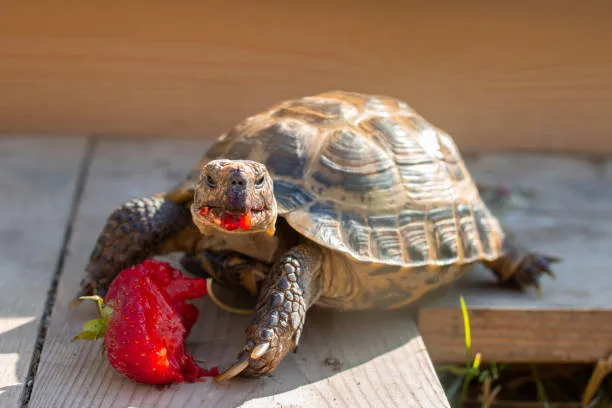
Every turtle owner worries about choosing the right food because diet decides a red eared turtle’s health, shell strength and lifespan. Many safe foods are known but when it comes to fruits like strawberries owners often feel confused. Strawberries look fresh, sweet and full of vitamins yet not everything that seems healthy for humans is always safe for turtles.
The clear fact is that turtles can eat strawberries but only in moderation. These fruits give hydration and nutrients but too much sugar can harm their digestion and long-term health. That is why knowing the safe amount and right way to feed is very important. In the next sections we will uncover the real benefits, the possible risks and the safe feeding tips. The full truth is more detailed than a simple yes or no
What Turtle Owners Must Know Before Feeding Strawberries
Red eared turtles can enjoy strawberries but only as a rare treat. These fruits are high in sugar and too much can upset their stomach and weaken health over time. A turtle’s main diet should be leafy greens, veggies, and some protein while fruits like strawberries should be limited to once or twice a week. Always wash them well, cut into small pieces, and watch how your turtle reacts after eating. This way you give a safe snack without risking its long life and strong shell.
Are Strawberries Healthy or Risky for Red Eared Turtles?
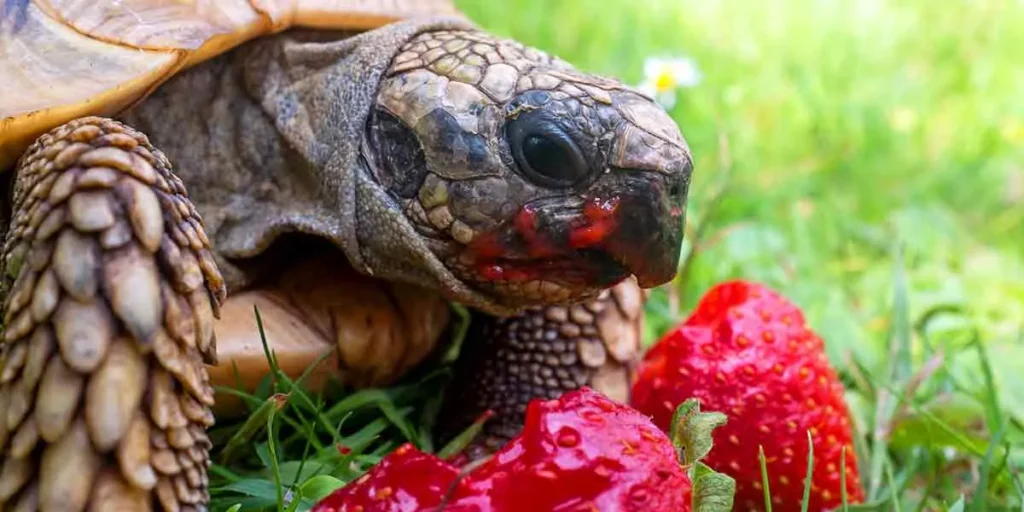
Red eared turtles can eat strawberries safely in small amounts, but too much sugar can harm their health. Knowing the benefits and risks helps you feed your turtle the right way.
Benefits
- Provides hydration to keep your turtle healthy
- Contains vitamin C and antioxidants for immunity
- Adds variety and enjoyment to the diet
Risks
- High sugar content can upset the stomach
- Overfeeding may cause obesity or slow shell growth
- Can lead to diarrhea or digestive problems if given too often
Nutritional Value of Strawberries for Turtles
| Nutrient | Benefit for Turtles | Why It’s Important |
| Water | Hydration | Helps your turtle stay hydrated, especially on hot days. |
| Vitamin C | Immune System | Keeps your turtle’s body strong and healthy so it can fight off sickness. |
| Fiber | Digestion | Helps your turtle’s tummy work properly and keeps its poops regular. |
| Antioxidants | Cell Health | Protects the turtle’s body cells from damage, like a little shield. Export to Sheets |
How Often Can Red Eared Turtles Eat Strawberries?
Here is a simple rule to follow:
1 Once or Twice a Month, at Most
This is the best way to keep your turtle healthy. A small piece of strawberry once or maybe twice a month is more than enough.
2 Use a Small Piece
Do not give your turtle a whole strawberry. A small, bite-sized piece is all they need. Imagine a piece that is about the size of your thumbnail.
3 Part of a Balanced Diet
Remember, a turtle’s main food should be turtle pellets, leafy green vegetables, and some other healthy foods. Strawberries are just a tiny, tiny part of their diet.
What Can Be a Safe Portion Size for Red Eared Turtles?
- Giving your turtle the right size is key. A small piece is all they need. Here’s how to figure out a safe portion:
- Think Small: The perfect size is about the size of a fingernail, or even a little smaller. It should be a tiny, bite-sized piece.
- One Small Piece: You should only give your turtle one small piece of a strawberry at a time. Never give a whole berry or a big chunk.
- The “Head” Rule: A good way to remember is to make sure the piece of fruit is no bigger than your turtle’s head. This helps to prevent choking and makes sure they don’t eat too much.
- Observe Your Turtle: After giving the small piece, watch your turtle to see if they eat it easily. This helps you know if the size is right for them.
can the Benefits of Feeding Strawberries to Red Eared Turtles
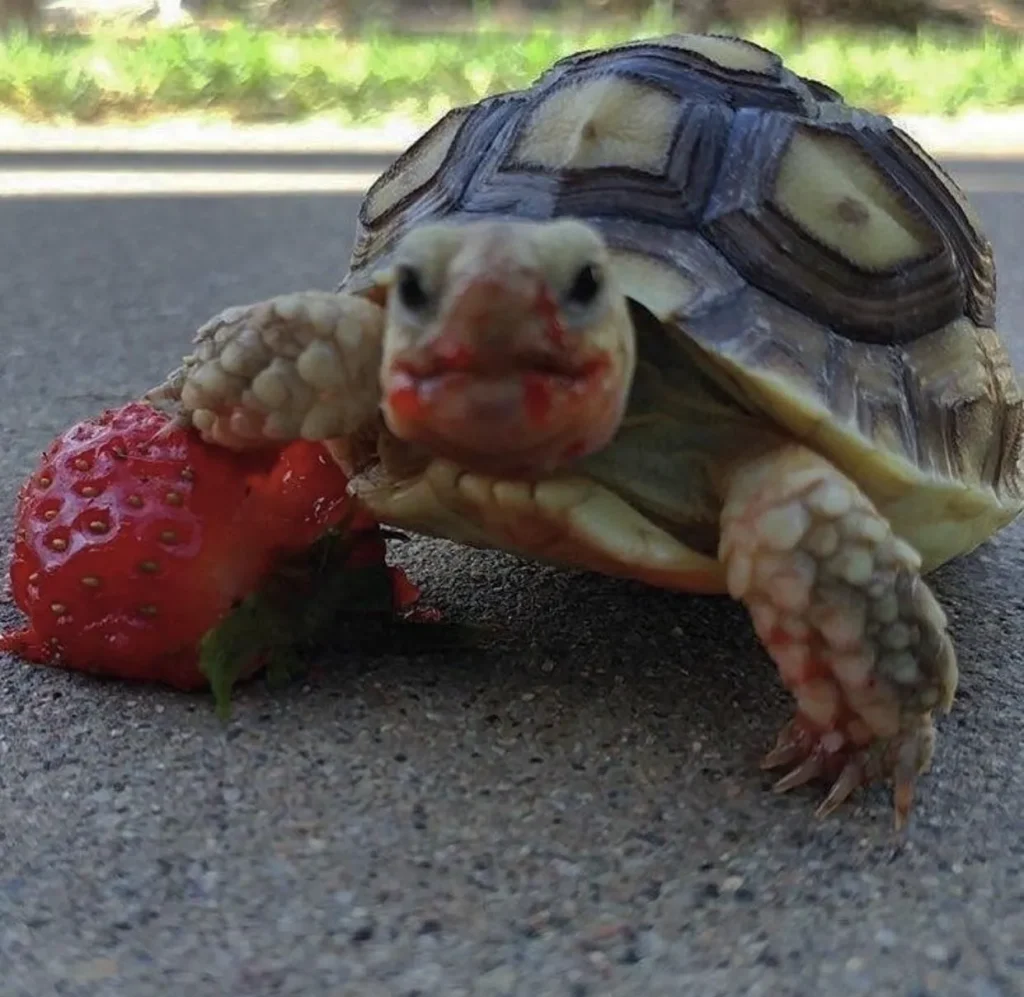
Feeding your turtle a small piece of strawberry once in a while can give them some good things. It is like a healthy, tasty treat that adds a little something extra to their diet.
- Provides Hydration: Strawberries are full of water, which helps keep your turtle hydrated.
- Contains Vitamins: They have Vitamin C, which is good for keeping your turtle’s body strong and healthy.
- Adds Variety: A small piece of strawberry gives your turtle a new flavor and texture to enjoy, which can make them happy.
- Offers Antioxidants: These are like little helpers that protect your turtle’s body from getting sick.
Possible Risks of Too Many Strawberries
While a little bit is fine, giving your turtle too many strawberries can be a problem. It’s like eating too much candy—it can make turtles sick.
1 Tummy Problems
Strawberries have a lot of sugar. Too much sugar can upset your turtle’s stomach, leading to diarrhea or other digestive issues.
2 Weight Gain
Just like in humans, too much sugar and not enough of their regular food can make a turtle gain unhealthy weight. This can lead to other health problems over time.
3 Nutrient Imbalance
If your turtle fills up on sweet strawberries, they might not eat the healthy foods they need, like their pellets and vegetables. This can stop them from getting important vitamins and minerals.
4 Shell Problems
Strawberries have a bad calcium-to-phosphorus ratio. Too much phosphorus can stop your turtle from absorbing calcium properly, which is very important for their strong shell and bones. Over time, this can make their shell soft and weak.
Best Alternatives to Strawberries in a Turtle’s Diet
| Food Type | Examples | Why It’s Good for Turtles |
| Leafy Greens | Romaine lettuce, kale, dandelion greens, collard greens | Full of vitamins, fiber, and calcium for strong shell and healthy growth. |
| Vegetables | Carrots, squash, bell peppers, zucchini | Provide minerals and nutrients without too much sugar. |
| Fruits (Occasional) | Blueberries, apples (no seeds), melon, mango | Safe treats with less sugar compared to strawberries. |
| Protein | Earthworms, crickets, boiled eggs, feeder fish | Important for energy, muscle growth, and shell strength (especially for young turtles). |
| Aquatic Plants | Duckweed, water lettuce, anacharis | Natural and easy-to-digest food that mimics wild diet. |
What Experts Say About Feeding Fruits to Turtles
When you ask a turtle expert about feeding fruits like strawberries, they will all tell you a similar thing: fruits should be a very small part of a turtle’s diet. Experts, like reptile veterinarians and experienced turtle keepers, know that a turtle’s natural diet is mostly green plants and some insects, not sugary fruits.
They stress that a turtle’s health depends on a balanced diet of high-quality turtle pellets and fresh leafy greens. Think of fruits as a special, once-in-a-while bonus, not a daily food. Giving too many fruits can cause health problems in the long run, even if your turtle seems to love them.
Here are a couple of important things experts often say:
Fruits are a treat, not a staple. The foundation of a healthy turtle diet must always be balanced pellets and fresh vegetables.
Too much sugar can lead to an unhealthy shell and internal problems. Always prioritize greens and safe vegetables over any type of fruit.
Can Baby Red Eared Turtles Eat Strawberries?
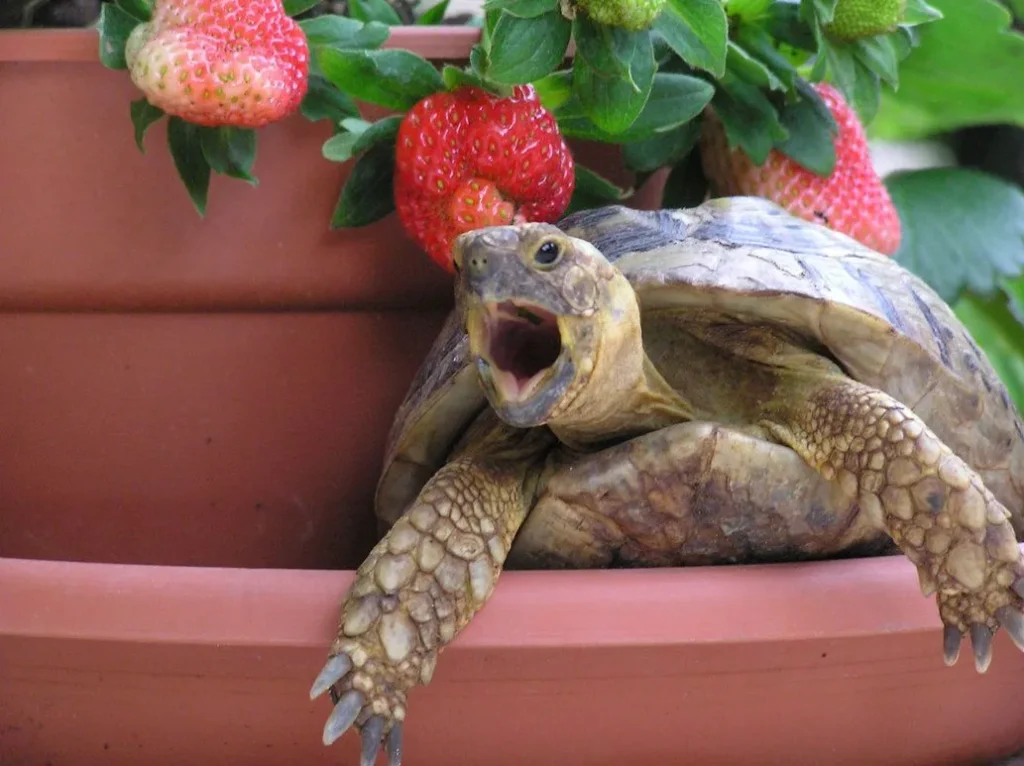
baby turtles have different needs than adult turtles. The simple answer is that it is better to not give strawberries to a baby red-eared turtle. Baby turtles are growing very fast and need a diet that is mostly made up of protein, like special baby turtle pellets and small insects.
Their tiny tummies can’t handle the sugar in fruits very well. Giving a baby turtle a strawberry can easily upset its stomach and give it too much sugar, which is not good for its health. You should wait until your turtle is older and bigger before you even think about giving it a tiny piece of a strawberry. For now, stick to their proper baby turtle diet to help them grow big and strong.
How will you know If Strawberries Are Harming Your Turtle’s Health?
- Even if you only give your turtle a little bit of strawberry, it is a good idea to watch for any changes. Here are some signs that a sweet treat might be causing problems:
- Changes in Poop: If you notice your turtle’s poop is very watery or runny, it could be a sign of an upset stomach from too much sugar.
- Eating Less: If your turtle suddenly stops eating its regular food, like its pellets and greens, it might be because it is full from the sugary fruit.
- Shell Feels Soft: A very serious sign is if your turtle’s shell starts to feel soft or spongy. This happens when they don’t get enough calcium, which can be a problem with a diet that has too much fruit.
- No Energy: If your turtle seems very lazy and is not as active as usual, it could be a sign that its diet is not giving it the right kind of energy.
- Changes in Behavior: Look for any strange behavior. Is your turtle acting differently? This could be a sign that something in its diet is not right.
How Do You Know If Strawberries Are Harming Your Turtle’s Health?
Sometimes, if a turtle eats too many strawberries, its body might show signs of it. A big problem is with their poop. It can become very loose and watery, which is a sign that their tummy is upset. You might also notice that your turtle seems bloated or has a swollen-looking belly.
This is because their body is having a hard time digesting all that sugar. Another thing to look for is if their appetite changes. They might not be as hungry for their regular, healthy food because they are full from the sweet fruit.
Behavioral Changes That Show Discomfort or Stress
- Lethargy: The turtle might seem very tired, lazy, and not want to move around or swim as much as usual.
- Hiding More: If your turtle is hiding a lot or not coming out to bask, it could be a sign that it feels unwell.
- Irritability: A turtle that is not feeling well might act a bit grumpy or refuse to be handled, which is not its normal behavior.
When to Seek Veterinary Help for Your Turtle
If the Symptoms Don’t Go AwayIf your turtle’s watery poop or lack of appetite lasts for more than a day or two, it’s time to call the vet.
1 Sudden Lack of Energy
If your turtle becomes very inactive and seems to have no energy at all, you should see a vet right away.
2 Shell Problems
If you notice your turtle’s shell is becoming soft, spongy, or is not looking healthy, get professional help immediately.
3 Any Serious Changes
If you are worried or notice any other strange or unusual symptoms, it’s always best to talk to a reptile veterinarian. It is better to be safe than sorry!When to Seek Veterinary Help for Your Turtle
Behavioral Changes That Show Discomfort or Stress
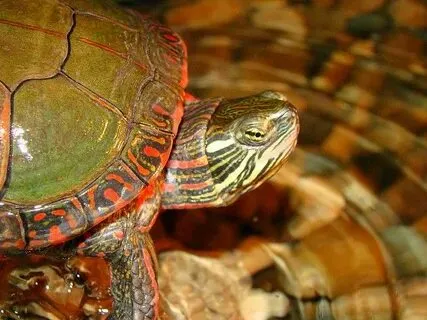
When a turtle is not feeling well from eating too many strawberries, it might start acting differently. You might notice your turtle is much less active than usual, not swimming or moving around its tank. It might also start hiding more often and not come out to bask under its heat lamp. Sometimes, a sick turtle can even become a little grumpy or refuse to be held, which is a sign of discomfort.
Safe Feeding Routine: Balancing Fruits, Veggies and Protein
| Food Group | What to Feed | How Often to Feed |
| Protein | High-quality turtle pellets, small insects like mealworms. | Daily for baby turtles. A few times a week for adult turtles. |
| Veggies | Leafy greens like romaine lettuce, dandelion greens, and collard greens. | Daily for adult turtles. A few times a week for baby turtles. |
| Fruits | Tiny pieces of strawberry, apple, or melon. | Once or twice a month at most. Only as a small, special treat. |
| Calcium | Cuttlebone or calcium blocks. | Keep a piece in the tank at all times so they can nibble on it when needed. Export to Sheets |
Faqs
Can turtles eat strawberry tops?
Yes, turtles can nibble on strawberry tops but only in small amounts because the leaves are safe yet not very nutritious. It’s better to use them as an occasional treat, not a main food.
Are strawberry leaves toxic to pets?
No, strawberry leaves are not toxic to most pets, but eating too many can upset their stomach. They should only be given in small, safe amounts.
What human food is safe for turtles?
Turtles can eat some human foods, but only the ones that are safe and close to their natural diet. Fresh vegetables, leafy greens and small pieces of fruits like apples, bananas or strawberries in moderation are good options.
Are strawberries pet friendly?
Yes, strawberries are pet friendly but only in small amounts. They give vitamins and hydration, yet too much sugar can upset a pet’s health.
Do strawberries attract mice?
Yes, strawberries can attract mice because their sweet smell and taste pull them in. If left outside or unsealed, they quickly become a food source for rodents.
Conclusion
Feeding strawberries to your red-eared turtle is a fun idea, but it’s important to be careful. While these fruits offer some vitamins and hydration, they are high in sugar and should never be a main part of their diet. Think of them as a tiny, rare treat, given only once or twice a month. The best food for your turtle is a balanced diet of high-quality pellets and leafy greens. By giving a safe, small portion and watching for any changes in their health, you can give your turtle a tasty snack without any risk.